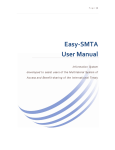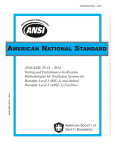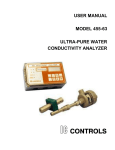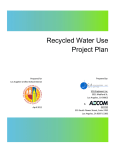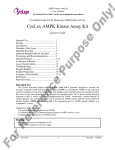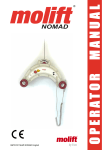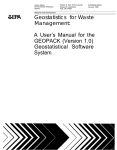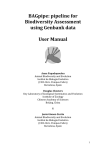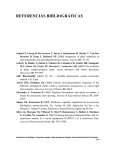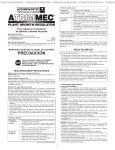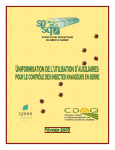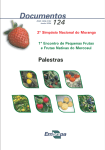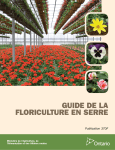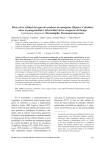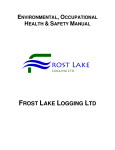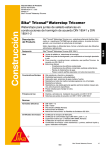Download Management Options for Nonpoint Source Pollution Greenhouse
Transcript
Management Options for Nonpoint Source Pollution Greenhouse and Container Crop Industries University Of California Cooperative Extension San Diego County - 1998 Disclaimer It is not recommended that the suggested management practices in this manual ever be taken and used as a basis for law. We understand that every operation is unique and requires a site-specific assessment of : a. Whether there is a need to implement further management, and b. Practices appropriate to a site. All information needed to implement these measures is not contained in this document. Acknowledgments Much of the information in this manual has been taken from the Clean and Green Water Quality Manual for Greenhouse and Nursery Growers, by the Horticultural Water Quality Alliance (1992). We have included information particularly relevant to the San Diego County area. The Alliance is a coalition of industry trade associations that is dedicated to the prevention of surface and groundwater contamination, to the promotion of safe pesticide and fertilizer use, and to the advancement of effective irrigation management and proper disposal of agricultural chemicals. For more information on the Alliance, contact: The Alliance, c/o The Society of American Florists, 1601 Duke Street, Alexandria, Virginia 22314-3406 Ph: (703) 836-8700 Fx: (703) 836-8705. A complete version of the Clean and Green Water Quality Manual for Greenhouse and Nursery Growers may be purchased from the Alliance. This project was funded by the United States Environmental Protection Agency, Region IX, Near Coastal Waters Program. Thanks to those who have made a contribution to this manual: Dr. Karen Robb, University of California Cooperative Extension, San Diego, Dr. Valerie Mellano, University of California Cooperative Extension, San Diego, Matthew Haynes, Mission Resource Conservation District, Fallbrook, Dr. Dave Fujino, Hines Nurseries, Inc., Mike Kidd, Vallecitos Water District, Chris Reilly, San Diego County Water Authority, Jim Purzycki, BAVCO Backflow Apparatus & Valve Co., Bill Painter, City of Escondido Water Department, Janet Ortiz, Department of Health Services, Dr. Marylynn Yates, Soils & Environmental Sciences UC Riverside, Richard Carlson, Department of Health Services, Dave Owen, San Diego County Farm Bureau, Jason Jackson, Natural Resources Conservation Service (NRCS), Greig Peters, Water Quality Control Board, San Diego Region 9, John Kister, Sunlet Nursery, Bruce Hall, Robert R. Hall Inc., Bob Mazalewski , Moennig’s Nursery, Jan Hall, Paul Ecke Ranch, Bob Echter, Dramm and Echter, Dr. Virginia Walter, Ornamental Horticulture Department, Cal Poly San Luis Obispo, Dr. Ursula Schuch, Botany & Plant Sciences Department, University of California Riverside, Dawn Neilson, Department of Agriculture, Weights & Measures John Blocker, Department of Agriculture, Weights & Measures, Carolyn Wells, GreenWay Compost, Marya Robbins, University of California Cooperative Extension, San Diego, Dr. Conrad A. Skimina, Monrovia Nursery Co., Richard Evans, Environmental Horticulture Department, University of California, Davis, Claude Boehm, Dept. of Environmental Security, Camp Pendleton Marine Corps Base, Howard Mueller, Natural Resources Conservation Service (NRCS), Dave Shaw, University of California Cooperative Extension, San Diego County Faustino Munoz, University of California Cooperative Extension, San Diego County, John Kabashima, University of California, Orange County, Neil Connelly, Jennifer Tierney, Pat Nolan, County of San Diego,Department of Agriculture, Weights and Measures i Table Of Contents Introduction to Management Options for Nonpoint Source Pollution: Greenhouse & Container Crop Industries ................................................................. 1 Irrigation Management and Water Quality Monitor Water Quality...................................................................................................... 1 Maximizing Irrigation Efficiency .................................................................................... 2 Irrigation Scheduling......................................................................................................... 2 Select Appropriate Growing Medium.............................................................................. 3 Consider the Use of Wetting Agents ............................................................................... 3 Reduce Leaching ............................................................................................................... 3 Publications on New Technologies.................................................................................. 5 Collect, Treat and Recycle Open Runoff/Tailwater Recovery.............................................................................................. 5 Collect Runoff From Outdoor Production Areas ............................................................................................................... 5 Collect Runoff From Field Drains and Non-Concrete Floors......................................................................................................... 6 Further Aspects of Reusing Water................................................................................... 6 Erosion/Drainage Control & Water Conservation........................................................................................................... 7 Management Practices ...................................................................................................... 7 Excess Water Removal ..................................................................................................... 7 Management Practices ...................................................................................................... 7 Pathogen Detection and Control ...................................................................................... 8 Cost-Sharing ...................................................................................................................... 8 Municipal Treatment Plants ............................................................................................. 9 Nutrients Fertilize Only When Needed............................................................................................ 9 Factors Influencing Fertilizer Choices............................................................................. 10 How to Read a Fertilizer Bag ........................................................................................... 11 Fertilizer Injectors............................................................................................................. 12 Use of Alternative Fertilizer Types ................................................................................. 13 Composting........................................................................................................................ 13 Lab Analysis - Determining Nutrients Available in Soil or Irrigation Water ............................................................................... 14 Monitor and Keep Track of Root Media pH and EC.......................................................................................................................... 15 Foliar Testing .................................................................................................................... 15 Water Testing .................................................................................................................... 15 Salts.................................................................................................................................... 16 Is There Salty Water in Your Future?.............................................................................. 16 Methods for Utilizing Salty Water................................................................................... 16 Salt and Boron Tolerances of Selected Ornamentals ....................................................................................................... 17 Integrated Pest Management (IPM) Planning Considerations ................................................................................................... 20 Adopt Good Management Practices ................................................................................ 21 Detect Pest Problems Early - Monitoring Tips................................................................ 21 Common Monitoring Techniques and Devices............................................................... 22 Integrate Biological Controls Where Effective ............................................................... 22 Consider Less Toxic Pesticides........................................................................................ 23 Pesticide Application Techniques.................................................................................... 23 Weigh All Pest Management Options Carefully............................................................. 24 ii Management Options for Nonpoint Source Pollution: Greenhouse & Container Crop Industries Introduction Water quality management involves a combination of interrelated practices needed to protect, improve, restore, or maintain water quality. Until recently, most of the effort directed toward control of water pollution involved easily identified sources of pollutants, such as sewage treatment plants or industrial facilities. This type of pollution is referred to as point source pollution. However, with the passage of the federal Coastal Zone Act Reauthorization Amendments or CZARA, another more elusive type of pollution that has no easily identified source has been targeted. This is referred to a nonpoint source pollution (NPS). Agriculture is one of several industries that have been identified as contributing to nonpoint source pollution. While it is impossible to locate the source of the pollutants, it is known that certain growing practices will contribute more to nonpoint source pollution, while other practices can minimize water quality problems. Current federal regulations have provided a very workable three-tiered approach for minimization of nonpoint source pollution. This begins with voluntary measures and moves toward stringent and strictly regulated criteria. Strict and inflexible mandatory regulations may be avoided by early voluntary compliance with initiatives to reduce nonpoint source pollution. This document was designed to provide the best available management options for the greenhouse and container crop industries. The intent is to allow the grower to comply with regulatory requirements at the voluntary level, and to avoid future, more stringent regulatory actions. Not all the management options described here are appropriate for every operation, and costs and complexity vary. In addition, as technology advances, new management options will be appropriate for these industries. Irrigation Management and Water Quality Water quality management involves a combination of interrelated practices that protect, improve, restore or maintain water quality. Managing runoff helps to protect water quality by reducing soil erosion from irrigation and rainfall, and minimizes contaminant carry over into surface and groundwaters. In addition to protecting water quality, the management strategies and techniques described in this chapter may streamline the efficiency and economy of your operation. Preventative measures to manage irrigation runoff can also be less costly than possible liability and fines. Please keep in mind that other practices may be appropriate for your growing operations, and that our set of practices is not all inclusive. Monitor Water Quality The first step in developing an irrigation management plan is to determine what is currently present in the runoff water, and in what concentrations. Excessive amounts of nitrate, phosphorus, other salts, pesticides and pathogenic organisms are the most common problems. For sources of analytical labs in the San Diego area, see the Appendix. The cost of a water analysis will be between $10 and $80, depending on the laboratory, and tests run. A simple test for nitrates and other nutrients is relatively inexpensive. However, a thorough chemical analysis will be more costly. If you elect this option, first inventory the chemicals used in your operation, particularly those most likely to end up in the water supply. Trace elements usually occur at very low levels in irrigation water runoff and only an initial and occasional analysis is necessary to see what these trends are. Boron is generally the most critical element, which has a narrow window of tolerance. Zinc is likely to be a problem only for those operations using biosolids in their media. It is important to note that how samples are taken, handled and analyzed can greatly affect the test results. Be sure the laboratory you select is equipped to give you the data you need, and then follow the instructions for sampling and handling that they provide. The lab should use EPA Standards and be certified for GLP (Good Lab Practices). Water quality monitoring should be done on a regular basis, and, as there may be seasonal variations, seasonal analysis is the best plan. All water quality records should be kept for at least 5 years. 1 Maximize Irrigation Efficiency Due to the high cost of water in San Diego County, most growers already practice some form of water conservation. Using less water initially is the best method of reducing runoff and associated problems. Runoff reduction techniques are much less costly to implement than large scale treatment and disposal procedures. Runoff can be prevented by several methods, resulting in less water and fertilizer use. Small savings in water and fertilizer costs can add up when you consider the profit per unit. A well-designed, efficient irrigation system is the foundation of a good water management plan. Adapting efficient irrigation technologies to your production systems will help reduce the amount of runoff, while keeping costs down. Low-volume application techniques such as drip irrigation and sub-irrigation do an excellent job of delivering water to containers and both can be very efficient. Overhead systems without trays to collect water and leachate, on the other hand, tend to create large volumes of runoff. Standing water can provide an environment conducive to certain insect populations as well as water-borne pathogens. Lots of standing water can lead to a problem with fungus gnats and shore flies. Irrigation Scheduling Common watering practices are imprecise at best. Some growers tend to rely on the "eyeball" method to determine when plants need water. As a result, many crops get more water than they need, creating excess runoff. Irrigation scheduling, based on environmental conditions, and regulating the length of irrigation time, will control water and fertilizer runoff as well as minimize weed growth. A variety of computers and irrigation scheduling software is available. The cost of such a system, balanced against the availability and expense of qualified labor, can be a very worthwhile investment. Resulting water savings can be tremendous in San Diego County. Pulse Irrigation. Pulse irrigation refers to the practice of splitting irrigations into smaller increments, thereby greatly reducing the amount of runoff as water becomes more available to the plant. Pulsing can work with sprinkler, drip, or sub-irrigation to minimize fertilizer and water waste. Pulse irrigation creates a very efficient system, applying only what is needed when it is needed. To ensure uniform delivery of water and fertilizer when using pulse irrigation, climatic conditions must be taken into consideration. Also remember that leaching is a necessity regardless of the type of irrigation system used. Irrigation water in San Diego County generally has an ECw (electrical conductivity) of 0.9 to 1.2 dS/m-1 (decisiemens per meter). Frequently what growers perceive as salts from the irrigation water that need to be leached is actually excessive fertilizer. When and How Much to Water. If you do not have a system to control irrigation, simpler methods can be used. With container crops, a target weight for watering must be set. The target weight can be determined in a couple of ways: The first method requires that you weigh several plants that are to the point of requiring water, average the weights and use that as the target weight to institute watering (This weight will vary depending on the type of plants being grown, plus other factors). The important point is to water the plants at the same level of dryness every time. The second method involves checking the weight of the container at full waterholding capacity, and then at the plants' point of wilting. The goal is to water most plants when 60 - 70 percent of the available water (or the difference between full capacity and wilting) has been used. This target, (for an average plant) allows plants on the edge of the bench that dry out more quickly to be near but not at the wilting point at the time of irrigation. The target weight may have to be increased as the crop grows. Controlling how long each application of water lasts can be accomplished with minimal investment under many circumstances. Seconds of irrigation time, not minutes, are important when it comes to reducing water consumption. Although they are still in the process of being tested, remote sensor tensiometers can be an effective aid but are expensive. 2 Select Appropriate Growing Medium Root medium can be selected for higher water holding capacity to improve the efficiency of irrigation. For example, rockwool, vermiculite, peat, or organic compost* will enhance water holding capacity and provide aeration, while polystyrene only adds air space to the mix. The greater the water holding capacity of the root medium, the less frequently watering will be necessary. At the same time, the need for leaching must also be minimized if there is to be any real advantage to higher water holding capacity. * Be sure to know the source of organic compost. Salts are always a concern. Be sure that ECe levels are acceptable, or plan to leach. Sometimes, simply filling the pots with more medium, or filling them more thoroughly and uniformly will increase water holding capacity per pot and decrease irrigation frequency. Careful watering will prevent media from splashing out of the pot. For information on good potting mix characteristics, desirable particle size guidelines, and physical properties of some media, see the Appendix. Nutrient-Holding Capacity. The nutrient-holding capacity of the root medium is an important consideration as well. Higher nutrient-holding capacity may not be necessary if fertilizer is applied regularly according to plant demand and with reduced leaching, or if resin coated slow-release fertilizers are used. Humic acid materials such as peat, will increase the nutrient-holding capacity substantially. Drainage and Aeration. Media designed for use in outdoor container plant production must be able to provide adequate drainage and aeration under conditions of heavy rainfall, and may need to be more porous or well-drained than greenhouse container media. Consider the Use of Wetting Agents Increased water absorption translates into more efficient utilization of the nutrients you apply. Research at Michigan State University found that wetting agents increase the water absorption of many peat-based media, when using either drip irrigation or sub-irrigation. Peat is notoriously difficult to wet. Wetting agents not only allow quicker wetting and uniform water distribution, but also allow more water to be held by the peat. In addition to assuring rapid wetting of dry root media and reducing channeling of water down the sides of pots, the use of wetting agents can also result in reduced leaching. The commercial mix you currently use may already contain a wetting agent. If so, you may not gain anything by adding more. If you decide to add a wetting agent, check in advance to see if there are any effects on your growing medium. Be sure to select a quality product designed for horticultural use. Don't over use wetting agents, as they can be toxic to plants and can be a leachate contaminant themselves. Reduce Leaching How much should you leach? Accepted growing practices dictate that in order to grow plants in containers, you have to leach frequently. The move from poorly drained, soil-based mixes to well drained, peat-based mixes has led to increased leaching. Since soilless media drain so well, it's easier to apply excess solution to make sure the medium is well saturated and leached, whether or not it's needed. The optimum amount of leaching is 10-15%. This means 10-15% of the water applied runs through the container. If you measure how much leaching occurs when you irrigate, you will realize how little water it takes to achieve 10 to 15% leaching. Drip Irrigation and Higher Leaching Rates. Drip irrigation may also lead to higher leaching rates. This may be due to the fact that water from drip tubes does not saturate some peat-based media rapidly or uniformly. Changing media components or adding wetting agents can solve this problem. Adding water slowly, in short bursts rather than one long irrigation, will also allow uniform wetting with less runoff. Try substituting two short applications of one minute each for one longer application of three minutes. Your interval time will depend upon your situation. Though time intervals will differ, this technique also has been used successfully in outdoor container production. 3 Low-Volume Drippers. Low-volume drippers will help reduce leaching if water quality is good and the drippers don't plug. Leaching is reduced because less water is applied at once, giving the soil more time to absorb it; also, more water goes where it's intended. Fertilizer Concentrations. When fertilizer concentrations are reduced, less leaching will be needed, and conversely, if leaching is reduced, you will need to use less fertilizer to avoid buildup in your containers. Application of Clear Water/Blending. Often times, applying clear water (where available) with no leaching, is sufficient, and no leaching will be required. Water and media analysis will provide you with information to help in your decision of whether or not to leach. Water treatments such as reverse osmosis are very expensive, and generally are used only on a limited basis, such as in propagation areas. Sub-Irrigation/Tray Benches to Collect Water. Trays to collect water and leachate can be used with overhead irrigation systems or hand watering. They provide a type of sub-irrigation and greatly increase the efficiency of overhead irrigation. This is a low-investment approach which can have a major impact on water and fertilizer use. Consulting an Irrigation Specialist. You may want to consult an irrigation specialist and/or consultant. These specialists can provide information which may improve on-farm water management. Irrigation system evaluations such as those provided by Mission Resource Conservation District and private consulting services can identify correctable problems such as worn nozzles, uneven spacing, uneven nozzle sizes, excessive run length, etc. Evaluations may also identify when and where over- or under-irrigation occurs. The Mobile Lab service is free. Contact the Mission Resource Conservation District for more information: (760) 728-1332. * Total salt content is usually reported as the electrical conductivity (ECw). Chemically pure water does not conduct electricity, but water with dissolved salts in it does. Electrical conductivity usually reported as decisiemens per meter (dS/m-1). Further Information NRCS Field Office Technical Guide (FOTG). FOTG contains information on the following irrigation water management practices: Sprinkler (Code 442), Trickle/Drip (Code 441), Surface and Subsurface (Code 443), Tailwater Recovery (Code 447), Nutrient Management (Code 590), Pest Management (Code 595), Toxic Salt Reduction (Code 610). Codes refer to conservations practices contained in the Field Office Technical Guide. You may also want to contact an NRCS technician for assistance. Water Use in California's Ornamental Nurseries. D.W. Burger, J.S. Hartin, D.R. Hodel, T.A. Lukaszewski, S.A. Tjosvold and S.A Wagner. California Agriculture 42 (9&10):7-8. Sprinkler Irrigation. 4th ed. C.H. Pair, W.W. Hinz, C. Reid and K.R. Frost, eds. Pub. by The Irrigation Association, Silver Spring, MD. 615 pp. Irrigation Practices: Measuring Sprinkler System Application Uniformity. R. Regan. Ornamentals Northwest Newsletter 11(1):10-12. Determining Sprinkler System Uniformity. D.W. Burger. Growing Media for Ornamental Plants and Turf. K. Handreck and N. Black. New South Wales University Press, Kensington NSW Australia. Media and Mixes for Container-Grown Plants. A.C. Bunt. Chapman and Hall, Hampshire, England. Greenhouse Operation and Management. P.V. Nelson. Reston Publishing, Reston, VA. Western Fertilizer Handbook. 7th ed., 1985. California Fertilizer Association. The Interstate Printers & Publishers, Inc. Danville, Ill. University of California Publications Tailwater Recovery Systems: Their Design and Cost. 1979. (#21063) 16 pp. Does Drip (and Other Low-Flow) Irrigation Save Water? 1984. (#21380) 4 pp. Drip Irrigation 1975. (#2740) 4 pp. Drip Irrigation Management . 1981. (#21259) 44 pp. 4 Publications on New Technologies Soil Moisture Measurements in Containers with Soil-State, Electronic Tensiometers. 1987. D.W. Burger and J.L. Paul. Hort. Science 22(2):309-310. Growth of Chrysanthemum Using an Irrigation System Controlled by Soil Moisture Tension. 1989. J.H. Lieth and D.W. Burger. J. of the Amer. Soc. for Horticultural Sci. 114(3):387-392. Collect, Treat and Recycle Open Runoff/Tailwater Recovery Minimizing irrigation generally is the most economical means of controlling runoff. However, collecting, treating and reusing runoff water can also accomplish the task. In San Diego County, this can save the grower money too. In greenhouses, the type of watering system and greenhouse floor used will determine how you collect excess water. For some operations, water collection from floors or field drains will be necessary in the short term. The preferred method, however, is closed systems where the water does not come into contact with the floor or the soil. The following practices are found in the NRCS Field Office Technical Guide. You may wish to talk to an NRCS technician or UC Farm Advisor to help you decide which practices most appropriately suit your situation. Agricultural Waste Management (Code 312). A planned system for managing runoff from concentrated waste areas. Such systems are planned to preclude discharge of pollutants to surface or groundwater and to recycle waste through soil and plants to the fullest extent practicable. Components include, but are not limited to the following: Tailwater Recovery (Code 447). A facility to collect, store, and transport irrigation tailwater for reuse thereby conserving water supplies. The quality of tailwater is dependent on the initial source, and handling by the grower. If there is a question regarding tailwater quality, have it tested. Runoff water usually is filtered and treated to control pathogens prior to its reuse in irrigation. Furthermore, special care must be taken in selecting and using pesticides, particularly herbicides, when reusing runoff. Plant damage may result. Nursery experts advise selecting herbicides with low water solubility; preferably below one part per million. Soil components play an important role in pesticide availability as well. Certain pesticides will adsorb to clay particles; this becomes a concern when erosion occurs and the particles wash downstream. Subsurface Drain (Code 606): A conduit installed beneath the ground surface to collect and/or convey drainage water. Its objectives are to: 1. Improve the soil environment for vegetative growth, reduce erosion, and improve water quality; 2. Collect groundwater for beneficial uses; 3. Remove water from heavy use areas, such as around buildings and roads, and accomplish other physical improvements related to water removal; and 4. Regulate water to control health hazards caused by pests such as liver fluke, flies, or mosquitoes. Collect Runoff From Outdoor Production Areas Reservoirs (Code 436). Collecting runoff in outdoor production generally involves channeling or piping runoff water into a collection reservoir located at a lower elevation than the production areas. Depending on site conditions, reservoirs may be earthen or lined with such materials as vinyl or concrete. Reservoirs normally are sized to hold runoff from irrigation as well as a moderate rainfall. Reservoir capacity should be designed on the basis of probable storm events. Contact the NRCS for a calculation of adequate reservoir size, and utilize qualified engineers for design and implementation. A permit may be required by the regional Water Quality Control Board (Waste Discharge Requirements). Reservoirs also should be designed to prevent seepage, another potential source of groundwater contamination Grassed Waterway (Code 412). A channel that is established using suitable vegetation for the stable conveyance of runoff. Suitable plant species may be selected with the assistance of an NRCS technician or other professional. 5 Lined Waterway (Code 468). A waterway or outlet having an erosion-resistant lining of concrete, stone, or other permanent material. It provides for safe disposal of runoff where unlined or grassed waterways would be inadequate. Properly designed linings may also control seepage, piping, and sloughing or slides. Structure for Water Control (Code 587). Can be used for water quality control, such as sediment reduction or temperature regulation. It works to control the direction or rate of flow, or maintain a desired water level in water conveyance systems. It controls the stage, discharge, distribution, delivery, or direction of flow of water in open channels or water use areas. Diversion (Code 362). A channel constructed across the slope with a supporting ridge on the lower side to divert water. Filter Strip or Vegetative Filter (Code 393). Sediments and other pollutants from runoff or waste water may be removed by the use of filter strips (an area of vegetation) which act to reduce pollution by filtration, deposition, infiltration, absorption, adsorption, decomposition, and/or volatilization. Strips vary in width depending upon site. They need to be managed carefully, including mowing, irrigation, fertilization and replacement every few years. (Based on experience in northern California, NRCS estimates 10'- 20' wide filter strips to cost approximately $75.00/acre). For references on filter strips, contact the Natural Resources Conservation Service (NRCS). Waste Utilization (Code 633). Waste can be used to fertilize, to provide forage and fiber, and to maintain soil structure and prevent erosion while also protecting water resources. Composting is an example of waste utilization . Storm Runoff. Many growers are required to capture storm runoff from production areas. This can be a significant volume of water to divert and hold. Therefore, it may be wise for growers to use space efficiently, eliminating hard surface areas and providing vegetative cover. Another tactic is to divert clean water from the production area so that it can leave the property. However, if the intent is to increase runoff for recycling purposes, harder, more impervious surfaces are preferred over more permeable surfaces. This method will reduce groundwater contamination, reduce fertilizer usage and return the maximum amount of water. Collect Runoff From Field Drains and Non-Concrete Floors Water Holding Areas. If you have a heavy, clay soil under your greenhouse, you can use field drains to collect runoff into a central location. The water storage area can be an earthen pond, a vinyl-lined pond, or an in-ground cement reservoir. Above-ground water silos can be less convenient because of the need to pump and lift water. Concrete Floors. At present, not all greenhouse operations in San Diego County irrigate in an open system such as those described above. With very porous soils that allow water to percolate quickly, concrete floors may be the best option to protect groundwater resources. For many greenhouse operators, concrete floors may not currently be economically feasible. Further Aspects of Reusing Water Nutrient Recycling. When reusing water, it is important to remember that nutrients are being recycled and therefore less nitrogen and other minerals will have to be applied. Testing for nutrient levels in the water source should be done to calculate how much more nutrient must be added. If this is not taken into consideration, salts can build up and damage crops. With analysis of the water, adjustments for pH and EC levels can also be made. The following chapter on nutrients addresses this in much greater depth. 6 Erosion/Drainage Control & Water Conservation The following practices relate to site specific issues. You may want to talk to an NRCS technician regarding what is appropriate for your operation. For more information on any of the following management practices, refer to the NRCS Field Office Technical Guide, or contact your local Natural Resources Conservation Service (NRCS) office. Management Practices Critical Area Planting (Code 342). Involves planting vegetation on highly erodible or critically eroding areas. It helps to stabilize the soil and reduces damage from sediment and runoff to downstream areas. Managing Roads (Code 560). Roads can be designed such that runoff is controlled, erosion prevented, and water quality maintained or improved. The type of construction, maintenance, and the road's location determine the road's effect on water quality. Placement of culverts and proper banking are factors in road design. Keeping culverts clean and maintaining waterbars or dips helps to avoid rutting and sedimentation. Over the long term it is more cost effective to properly design a road and perform upkeep than to have to deal with damage that results from not doing so. The Natural Resources Conservation Service (NRCS) can assist you in designing your roads. Underground Outlet (Code 620). A conduit installed beneath the surface of the ground to collect surface water and convey it to a suitable outlet. Its purpose is to dispose of excess water from diversions, subsurface drains, surface drains, principal spillways from dams (outside the dam area only), without causing damage by erosion or flooding. Constructed Wetlands (Code 359). Are presently being evaluated for their ability to clean up runoff. They can serve as a biological filter for removing chemical pesticides and fertilizers. In addition, the extra water surface of the wetland area increases the oxygen available to decompose organic compounds and to oxidize dissolved metals in the water. Constructed wetlands have proven effective in filtering out sediment and nitrate in other parts of the country. One drawback, however, is that a certain amount of acreage is necessary for the practice to be effective. This will rule out many growers with limited acreage. In addition, many landowners are hesitant to install a wetland area on their property because of possible limitations on land use in the future. Work remains to be done on this technique in California, but the outlook is promising for many areas. As of yet, no one in San Diego County is using this technology. Further Information on Management Practices for Sediment Control (Videos) Best Management Practices for Sediment Reduction video (not specific to greenhouse and container crops) available in English and Spanish. By the University of California Cooperative Extension. Farmer to Farmer video (not specific to greenhouse and container crops). By the West Stanislaus Resource Conservation District. Excess Water Removal While water is expensive or in short supply in San Diego County, there is a silver lining to this situation. With respect to nonpoint source pollution, San Diego County is fortunate because it simply does not have the quantity of water to allow for activities conducive to causing the pollution problems found in other parts of the nation. Only occasionally is excess water removal a problem. Excess water removal includes a combination of interrelated conservation practices needed to prevent flooding, manage runoff, and provide drainage within the plant root zone. Previously mentioned practices include diversions, reservoirs, structures for water quality control, lined waterways, and subsurface drainage systems. Also consider the following: Management Practices Berms or Dikes (Code 356). An embankment constructed of earth or other suitable materials to protect land against overflow or to regulate water. Dikes are often used to prevent overflow, provide better use of drainage facilities, prevent damage to land and property, and facilitate water storage and control. 7 Roof Runoff Management (Code 558). Roof management facilities include but are not limited to erosion resistant channels or subsurface drains with rock-filled trenches along building foundations below eaves, roof gutters, downspouts, and appurtenances. The purpose of such a system is to prevent roof runoff water from flowing across concentrated waste areas, barnyards, roads and alleys, and to reduce pollution and erosion, improve water quality, prevent flooding and improve drainage. Pathogen Detection and Control Types of Pathogens Encountered. In container crops, the most common root pathogens are the fungi Phytophthora_Phytophthora, Pythium_Pythium and Rhizoctonia. Bacteria can also be spread by water, but usually do not enter the roots unless there is existing root damage. The species of pathogens found in your area, as well as local environmental conditions such as temperature and humidity will influence the types of pathogens you encounter and the rate of infection. Pathogen Problems. Where water goes and how it is collected will determine the potential for pathogen problems. Topwatering systems, where water passes through the organic media in containers and then is collected off the ground, have the greatest potential to spread pathogens. However, greenhouse and container crop operations in San Diego County using open recirculation have not found this to be a problem. The type of crop generally dictates whether you need to treat recirculated water for pathogen control before using it again. Consult your local Farm Advisor for this information. Treating Recycled Runoff Water. Chlorine and bromine can be used to treat recycled runoff water. Chlorination involves the use of granular calcium chloride or gaseous chlorine, although the latter should be used only for larger operations. The key is having enough free chlorine (about 0.5 ppm) in the water long enough (roughly one minute) to kill pathogens. Various techniques, such as double loop intake lines or the injection of chlorine in the surface water where it enters the suction line, have been used to increase exposure time. The pump’s impeller further aids mixing. If you choose to work with chlorine, remember that chlorine gas is very hazardous and must be handled with adequate safeguards. There are standards for the chlorine concentration in runoff water, which are lower than the standard acceptable level in drinking water. Remember that any chemical water treatment will need to be included in your overall hazardous materials management plant and conform to current pesticide regulations. The newest agent available to control water borne pathogens is a bromine biocide, commonly known as Agribrom. The concentration required is higher (5 to 10 ppm of free residual bromine), than chlorine. The manufacturer claims that it is safer to handle than chlorine and is equally effective, if not more so. Exposure time is about the same as for chlorine. Heat treatment of water to 95° C, ozonation, or the use of ultraviolet irradiation and ultrafiltration also can work and may be viable for you. Anything less allows some pathogens to enter a survival mode and produce heatresistant spores. Cost-Sharing Environmental Quality Incentives Program (EQIP). A federally funded program designed to solve soil, water and related resource problems through cost sharing. EQIP assistance is available to install a variety of measures to control erosion. These practices also help farmers reduce sediment and chemical waste. A project must be able to demonstrate significant conservation benefits like water savings or erosion reduction to be eligible for cost-sharing. Further information may be obtained from Agricultural Stabilization and Conservation Service (ASCS) or Natural Resources Conservation Service (NRCS) staff. The San Diego/Riverside County ASCS office is in Indio. Their address is: 45691 Monroe St., (760) 347-3675. CAIF. Grants from $2,500 to $80,000 are available for project having a direct effect on Carlsbad agriculture through the Resource Conservation District (RCD) of Central San Diego County (760-745-2061) as well. Projects are not limited to water or soil conservation. 8 Municipal Treatment Plants Depending on the local sanitary district, dry season runoff may or may not be permitted to be discharged into local municipal waste water treatment systems. However, if it is permitted, the discharge is usually restricted to off-peak hours, and user fees are typically high. Since most treatment facilities are quickly becoming overloaded, this approach is a short-term solution for the disposal of dry season runoff. The Status of Storm Water Permits. The greenhouse and container crop industries are not currently included in the storm water permitting process. The possibility exists that both of these industries (which are somewhat independent of the soil compared to field grown crops), may some day be included under the requirements of the Industrial Stormwater Permit process. For more information, contact Regional Water Quality Control at (619) 467-2952. Nutrients The balance of crop nutrients is important in producing vigorous, efficient plants. This chapter will discuss many of the considerations a grower has when developing a fertilization plan. These include the timing of fertilization, the use of alternative fertilizer types, composting, lab analysis, fertilizer injectors, backflow preventers, and salts. In most cases today, fertilizers are applied as a continuous l iquid feed—soluble fertilizers are injected directly into the irrigation water, either at each irrigation or at regular intervals. However, several local nurseries have been reported to have switched to all slow-release granular fertilizers and seem to have eliminated both the nitrate and phosphorus problem. The concentrations of NO3- and PO4 in the runoff is often less than the concentration in the original groundwater that is used for irrigation. For more information on developing a fertilization plan, see the Natural Resources Conservation Service (NRCS) Conservation Practice Standard “Nutrient Management” (Code 590). It addresses management of the amount, form, placement, and timing of applications of plant nutrients to supply nutrients for optimum yields, while minimizing contamination of water sources. Nitrate. The groundwater contaminant most often detected is nitrate. The primary causes of nitrate contamination in groundwater are the improper disposal of human and animal wastes and the overuse of chemical fertilizers. Most of the nitrogen in water comes from nitrates produced by or added to the soil. Nitrogen may be added to the soil in the form of chemical fertilizers containing nitrates, ammonium, or compounds that are converted easily to ammonium (NH4+), which later is converted to nitrate (NO3-). (Even “organic” fertilizers contain nitrogen that is converted to NO3-.) Nitrates are extremely soluble in water and can move easily through soil into drinking water supplies. High levels can build up over time as nitrate accumulates in the water. The maximum contaminant level or MCL for drinking water is 45 mg/l of NO3- or 10 mg/l of NO3-N. Ingesting excessive amounts of nitrate poses a health hazard to infants under six months of age and some susceptible adults, causing condition called methemoglobinemia (or blue baby syndrome), which reduces the ability of the blood to absorb oxygen. 0.5-1.5% methemoglobin in the blood is normal; more can start to cause problems. Nitrate in groundwater is a danger sign not only because of the potential adverse health effects associated with nitrate, but also because it is often an indication that groundwater is vulnerable to degradation by other contaminants such as pesticides, bacteria and viruses. Phosphorus. Phosphorus is primarily a problem in surface waters. In greenhouse and container crop production, a more water-soluble phosphorus is used as a vital nutrient. This element can get into streams, creeks and other surface water repositories, causing a condition of excessive algal growth known as eutrophication. Removing nitrate and phosphorus from drinking water sources is much more difficult and expensive than preventing the contamination in the first place. Fertilize Only When Needed 9 New water management schemes have required that optimum levels of fertilization be revised. In many cases, present recommendations have been found to be in excess of what the plant actually needs. Therefore you may want to develop your own plan. San Diego County produces a huge variety of flower and nursery crops, and specific fertilization requirements may not be available for the crops you produce. Fertilizer Residue From Previous Applications. Since fertilizer is not particularly expensive, many growers use excessive amounts to ensure optimum plant growth. This practice is a major contributor to the high levels of nitrates present in irrigation runoff. When fertilizing pots, consider the amount of fertilizer still in the container from former fertilizations. Also, remember that the greater the volume of solution applied, a greater proportion of fertilizer salts are leached from the pot; the lower the volume of solution applied, the more fertilizer remains in the pot. Nutrient Concentrations. The choice of nutrient concentrations is an important topic that often is inadequately addressed. This is particularly true for the application of nitrogen (N). Plants frequently take up considerably less nitrogen and water than the amounts applied. You need to evaluate crop needs and fertilize appropriately. Nutrients In Recycled Water. If you are reusing your water, there is a good chance that there will be unused fertilizer dissolved in it. This should be taken into account when determining the level of fertilization for your crops. One local grower was able to reduce his fertilizer application by 30% by taking into account the nitrogen level of the recycled water. The Key to Proper Fertilizer Use. The key to proper fertilizer use is regular applications, controlled leaching and weekly analysis of the electrical conductivity (EC) of the root media. Many plants can be grown with low nutrient concentrations if the supply is constant. Weekly evaluation of pH, EC and fertility applications will prevent most nutritional problems you may encounter. A conductivity or soluble salt meter is a tool you can use to determine how much fertilizer is present and whether more is required. Make a chart to keep track of EC values on a weekly basis. If the EC value is dropping below the optimal level, you can increase the concentration of the fertilizer solution, while maintaining the volume of the solution being applied. If the fertilizer program is resulting in too high an EC, switching to a lower fertilizer concentration or to clear water will bring the EC back into range. Fertilizing only when needed based on media analysis and charting of EC levels can greatly reduce the amount of fertilizer applied, and often yields better crops. Application Timing. Timing is very important. Fertilization rates in the early stages of growth depend on the plant’s growth rate. Using less fertilizer early in the plant’s development encourages root establishment. Rooted cuttings or newly potted liners should receive reduced levels of fertilizer (a third of normal production levels) until plant roots become established. When leaf growth starts, increase fertilization. Once roots are established, fertilizer levels must be maintained during the stage of active vegetative growth, but should be reduced during the stages of growth or seasons when the plant cannot use the fertilizer. Factors Influencing Fertilizer Choices Most commercially available fertilizers are "general purpose," containing different nutrients in combinations predetermined to promote optimum plant growth. However, custom blending of fertilizers often best meets the needs of specific crops. A complete 20-20-20 fertilizer contains 20 percent nitrogen, 20 percent P2O5 and 20 percent K2O by weight. If a grower is directed to apply 200 parts per million (ppm) of nitrogen to a crop, what will result? If you apply 200 ppm nitrogen, there will also be high levels of phosphorus (P). Any excess fertilizer, unused by the plants, represents chemicals—and money—down the drain, as well as a potential environmental contaminant. Many of the practical aspects of nursery and container crop nutrition and fertilization are covered well in widely available texts. The best approach is to consider several recommendations and then use common sense and experience to develop a fertilization plan for your own operation. 10 In addition to irrigation water and root media chemistry, other factors, such as root medium components, temperature and slow-release versus constant liquid fertilization (CLF) application methods, micronutrient deficiencies, and application timing influence fertilizer choices. These are addressed briefly below. Soilless Media and Trace Elements. Some water-soluble fertilizers are formulated specifically for soilless media. These formulations contain higher micronutrient concentrations and less ammoniacal nitrogen. Soilless Media and Ammonium Nitrogen. Ammonia toxicity problems can occur in soilless media because of high levels of ammonium or urea fertilizer. As mentioned earlier, the 20-20-20 mixes typically contain about 70 percent ammoniacal nitrogen, a rate too high for many plant species growing in soilless media. Formulations such as 20-10-20 Peat Lite Special contain just 40 percent ammoniacal nitrogen, a safe level for year round use. Ideally, no more than 50 percent of nitrogen fertilizer should come from the ammonium form. Ammonium can cause toxicity on some plants when the soil is cool and waterlogged, when the ammonium is converted to ammonia. How to Read a Fertilizer Bag The judicious use of fertilizers can boost crop production tremendously. However, the misapplication of fertilizers can reduce your profit margin and cause harm to the environment. The following is a guide to the information found on a hypothetical bag of fertilizer. All of the ingredients listed here may not be found in all fertilizer formulations. Primary plant nutrients are used in considerable quantities by crops and include Nitrogen, Phosphorus and Potassium. Secondary plant nutrients include Calcium, Magnesium and Sulfur. These elements are used in moderate quantities by crops and can effect soil pH. Micronutrients or Minor Elements include Zinc, Iron, Manganese, Copper, Boron and Molybdenum. While these elements are used in very small quantities, they are essential for plant growth. Nitrate, NO3-, is the most readily available form of nitrogen to plants. However, it moves through the soil very easily with irrigation water and can be lost to leaching through over-irrigation. Excessive soil moisture conditions can lead to denitrification. This is a process where soil bacteria turn nitrate into nitrogen gas, N2 ,or nitrous oxide gas, N2O. These gasses are lost to the atmosphere. Both of these gasses are considered greenhouse gasses. All ammoniacal based fertilizers start out life as ammonia, NH3 . Ammonia is a gas at normal temperatures and is difficult to handle. Adding one more hydrogen atom creates ammonium, NH4+. Ammonium is dry and stable at normal temperatures. While plants can absorb and utilize ammonium, it is easily tied up by soil particles and becomes immobile. Eventually, soil bacteria will convert ammonium into nitrate. This is known as nitrification. The rate at which nitrification occurs depends on soil temperature, soil moisture levels, etc. For the most part, the warmer a soil is (assuming adequate moisture), the quicker nitrification will occur. Urea, CO(NH2)2, is generally the cheapest form of solid nitrogen. Urea is very soluble in water and is a good choice for use in injection systems. This solubility makes urea very leachable when first applied. Once in the soil, urea is changed through enzymatic action to ammonium. At this point it becomes available to plants. Minor Elements are essential for good crop production. However, the line between deficiency and excess or toxic levels can be very fine. Often, chelating agents are included with minor elements. Chelates are organic compounds that bind to a minor element and delay it from forming insoluble compounds. This makes the chelated element available to plants for a longer time. The grade of a fertilizer indicates the percentage by weight (in order), of total nitrogen, available phosphoric acid and water soluble potash. Example - The grade of a particular fertilizer is 15-15-15. This indicates that the bag contains 15% nitrogen, 15% phosphorus pentoxide (P2O5), and 15% potassium oxide (K2O). The label does not say 15% phosphorus or 15% potassium. Both of these constituents are reported in their oxide forms rather than their elemental forms. To covert P 2O5 into elemental phosphorus, multiply by 0.44. To convert K2O into elemental 11 K, multiply by 0.83. Thus, a 100 pound bag of 15-15-15 fertilizer contains 15 pounds of total nitrogen, 6.6 pounds of phosphorus ( 15 X 0.44), and 12.5 pounds of potassium (15 X 0.83). The phosphorus content of fertilizers is stated as Available Phosphoric Acid. Phosphorus can be expressed in its elemental form P, or in an oxide form, usually P2O5 or phosphorus pentoxide. Plant requirements for phosphorus are commonly expressed in the elemental form, whereas the analysis of fertilizer is usually stated in the oxide from. To convert, multiply the elemental form by 2.3 to find out how much oxide form you need. Phosphorus is easily bound to soil particles and resists leaching. Because of this, the vast majority of phosphorus contained in the soil is unavailable to plants at any given time. The potassium content of fertilizer is expressed as Water Soluble Potash. Potassium is taken up by plants in the form of K+. Like phosphorus, plant requirements for potassium are expressed as the elemental form while fertilizer is sold in the oxide form of K2O or potassium oxide. To convert from the elemental form to the oxide form, multiply by the elemental form by 1.2. Sandy and coarse textured soils do not hold potassium well, making it susceptible to leaching. How much and what type of fertilizer do you need? You’ll never accurately know unless you perform regular media and leaf tissue testing. DON’T ASSUME! What you did last year may not be adequate this year. Purchase and apply only the nutrients you need. This not only benefits the environment, but your profit margin as well. Slow-Release Versus Constant Liquid Fertilization (CLF). Preplant incorporation of slow-release fertilizers reduces nutrient runoff and nitrate contamination as compared to the use of highly soluble fertilizers in a CLF program. Temperature is a factor however, when some slow-release fertilizers are used with fertilizer sensitive crops like bedding plants. High temperatures can lead to accelerated rates of fertilizer release. Pay attention to soluble salt levels and leach only when necessary to reduce salts. Keep in mind when choosing your application methods that nitrogen fertilization follows the front of water. Ask vendors of slow-release fertilizer to help you develop and implement the correct program for your site. Split applications of slow-release fertilizers (applying some preplant and the remainder part way through the crop cycle), are more efficient than a single application. Combining liquid and slow-release fertilizers can also work well to attain maximum productivity with the least amount of waste. The best possible fertilizer blend for your situation can be obtained from one of the many companies in the United States that markets custom fertilizers, or you may mix it yourself. The end results will be better quality plants, less chemical contamination of surface and groundwater and, in all probability, savings in overhead expenditures. Further Information Principles of Plant Nutrition. 3rd ed. K. Mengel and E.A. Kirkby. International Potash Institute, Worblaufen-Bern, Switzerland. Carnation Production II. W.D. Holley and R. Baker. Kendall/Hunt Publishing, Dubuque, Iowa. Roses: A Manual on the Culture, Management, Diseases and Insects of Greenhouse Roses. Langhans, R.W, ed. Roses, Inc., Haslett, MI. Introduction to Floriculture. 2nd ed. R.A. Larson, ed. Academic Press, San Diego, CA. Greenhouse Operation and Management. P.V. Nelson. Reston Publishing, Reston, VA. Soil Fertility and Fertilizers. S.L. Tisdale, W.L. Nelson and J.D. Beaton. Macmillan Publishing, N.Y. Fertilizer Injectors Much has been written about liquid fertilizer programs since methods of dispensing chemical salts through accurate fertilizer injectors (also called fertilizer proportioning equipment) have been devised. New fertilizer injectors seldom produce the erratic results of earlier models. The option of controlling nutrient applications with pinpoint accuracy can prevent groundwater contamination and facilitate the recycling of leachate water for fertilization. Newer, programmable fertilizer injectors can allow for changes in the concentrations of individual nutrients according to growing conditions within and outside the plant. 12 With some new injectors, the concentration of individual nutrients can be adjusted independently, according to the needs of the plants. This requires the use of several fertilizer stock tanks or a change in the injector ratios. However, many growers prefer to use the same mix for all crop types. Precise nutritional prescriptions can be formulated when nutrient uptake estimates are correlated with the environmental and physiological conditions of the plants at the time of sampling. The result is delivery of nutrients to the plant's roots when plants need it. Ease of application, flexible adjustment of nutrient supply, and control of soil pH are advantages of a liquid feed program. Major drawbacks are the high cost of equipment, and the necessity for employees with the technical knowledge required to operate and maintain the equipment. Liquid and controlled-release methods require a sizable initial investment in equipment or materials, but later require limited labor. Al though equipment investment for granular application is low, high labor requirements may result in higher costs than any other system in the long run. Some larger nurseries are moving away from using liquid fertilizer injection (due to increased loss of nitrates, etc.) to using slow-release fertilizer in preplant or topdress. In some situations it is more cost-effective, reliable, and environmentally sound. The success of slow-release fertilizers is dependent on many factors (e.g. the number of crop types, how long they will be in containers, etc.) Use of Alternative Fertilizer Types Manures and composts can be good potential sources of plant nutrients, as well as good soil conditioners, depending on the type of manure and the quality of handling and storage. Poultry manure (aged) has been recommended by some growers. The exact residual nitrogen release must be determined by careful monitoring of crop performance and use of soil and plant tissue analysis. If residual release is not taken into account, over-fertilization can result. In addition, manures are high in salts, therefor management for salts must be taken into account. Phosphorus (P) and Potassium (K). Animal manures and composts are excellent sources of plant-usable phosphorus and potassium. In neutral or acidic soil, phosphorus in manure is worth 70 to 90 percent of phosphorus in superphosphate fertilizers. In calcareous (high-pH) soils, manure phosphorus is worth 100 percent or more of phosphorus in superphosphate fertilizers. This is because inorganic phosphate tends to undergo precipitation reactions and become unavailable to plants in high-pH soil. Some native soils in San Diego County tend to be high in pH. However, growing media are often neutral or low pH. Also, availability of phosphorus in manure is relatively insensitive to cool soil temperatures near 60° to 65° F. Salts and Weed Seeds in Livestock Manures. Salts in animal manures can accumulate to undesirable levels in the soil when excessive amounts are applied or irrigation and precipitation are inadequate to leach the accumulated salts from the root zone. Composting does not reduce the salt level unless the compost is leached, which isn’t recommended. Manure that has not been properly composted can also contain viable weed seeds. Composting The nitrogen (N) content of composts is often of great interest to growers who want to know what nitrogen contribution they can expect from a given application of compost. Others consider compost to be a soil conditioner, and not a fertilizer material. For both economic and envi ronmental reasons, minimizing nitrogen losses from composting and cropping systems is important. When excess water is added to a compost pile, either through irrigation or precipitation, the surplus water leaches through the system. This water can carry significant amounts of organic nitrogen, ammonia and nitrate, especially early in the composting process. Nitrogen losses from this process can be avoided by preventing the addition of excess water to the compost pile or by recycling leachate back into the pile. Composts also contain many other macro- and micronutrients. In the absence of losses due to leaching, most mineral nutrients are conserved during composting. In addition to serving as a source of nutrients, composts may affect the availability of nutrients in the soil. Composts can increase the cation exchange capacity of soils, thus allowing 13 increased availability of calcium, magnesium and potassium. Composts can help neutralize and buffer soil pH as well; this may increase the availability of many plant nutrients which become less available when soils become too acid or alkaline. The addition of compost to the soil and its further decomposition can also stimulate soil microbial diversity and activity. The diverse microbial communities which can exist in composts and compost-amended soils may include organisms which reduce pathogenic microbe populations and/or activity through a variety of mechanisms, including competition, parasitism and antibiosis. The level of pathogen suppression of some composts is sufficiently high that they are used specifically for this purpose in container soils in the horticultural industry. Given the number and diversity of factors that contribute to compost quality (See table below), evaluating the quality of a given compost takes some thought. The quality of compost that is intended for use in a container mix has to be high. The quality of a compost is determined primarily by two factors: the composition of the base materials and the composting process; this information should be available to the customer at no cost. Many compost producers may also provide laboratory analysis data for plant nutrients, salts, and/or contaminants such as heavy metals and pathogens. There is a trend to standardize compost to give growers an idea of what they’re getting when making a purchase. Compost quality is regulated by the EPA 503 regulations when the material contains biosolids. California State green waste regulations have also been developed. Compost quality characteristics include: Chemical Biological Physical pH Maturity/activity Particle size Nutrients Weed seeds Contaminants Salts Animal pathogens Degradation Metals Plant pathogens Organic Pathogen suppression compounds Plant response (pesticides, etc.) Modern Potting Composts. Penn. State Univ. Press, University Park, Penn. Lab Analysis - Determining Nutrients Available in Soil or Irrigation Water Soil and water quality tests are essential components of sound greenhouse and container crop management practices. Soil Testing. Soil testing should be conducted on a regular basis. Along with plant tissue analysis, soil tests are the grower’s best guide to effective use of fertilizers. There are several common methods used for soil analyses, particularly in terms of the chemicals used for extraction. San Diego County labs are listed in the Appendix. Tests cost between $15-$80, depending on the lab and the type of test. Interpretation of soil tests should be done with the help of an experienced agricultural consultant, preferably one who is familiar with greenhouse and container crops. Important indicators to look at include: pH, EC and sodium adsorption ratio (SAR). Keep in mind that the recommended levels for nutrients can be reported in a number of ways and are based on the type of soil test that was performed and the crop being grown. Additionally, soil and growing media components can vary considerably and other factors (particularly soil pH) must be considered when calculating micronutrient availability. Taking Soil Samples. Soil testing should be done regularly as a preventive measure to avoid deficiency or toxicity problems. If a good fertilization program is followed, initial and semiannual tests are usually sufficient for outdoor container crops. Monthly soil testing for nutrient levels is necessary only for the faster growing greenhouse crops (or, "fast turn crops"), and pH and EC tests should be done frequently. It is important to obtain representative soil samples in order to make valid decisions after testing. Most laboratories can provide instructions and containers in which to place samples. Also factor in the turn around time for labs versus the usefulness of the information. Interpreting Soil Test Results. The interpretation of soil test results should be coupled with information from the fertilization program, trends in relation to previous analyses, foliar analyses, and the appearance of visual symptoms of nutrient disorders. 14 Further Information Conducting and Interpreting Soil Tests. L. Dodge and R. Evans. Monitor and Keep Track of Root Media pH and EC Container mixes are generally porous, well aerated and have a high proportion of organic material. Such mixes characteristically have a low pH and require amendments, such as dolomite or limestone, to raise the pH to the desirable range of 6.0 to 7.0. Reduction of high pH in a container mix can be accomplished by addition of fine sulfur, but results are not long lasting and are quite variable. Foliar Testing Foliar testing is an important procedure that can help guide your fertilization program. Foliar levels of nutrition are available for some potted crops. Thus, plant tissue testing is a recommended practice, both prior to establishing a fertilizer program and on a regular basis to prevent the onset of nutrient deficiencies. San Diego County labs are listed in the Appendix. Tests cost approximately $20-$70, depending on the lab and the tests run. Further Information Soil and Plant Tissue Testing in California. 1983. University of California (#1879). 56 pp. Plant Analysis Handbook. J. Benton Jones, Jr., B. Wold and H.A. Mills. Micro-Macro Publishing, Athens, GA. Water Testing Most water from municipal systems needs to be tested once a year, but surface water from ponds or creeks may need to be tested as often as every four to six months. These water supplies often have seasonal variations. Irrigation Water Tests provide information about potential toxicity problems, as well as information that is useful for formulating fertilizer programs. Some elemental constituents (organic and inorganic materials) are important because they indicate how much of a particular nutrient may be added in the irrigation water. Others are important because they affect soil pH or are toxic to plants. The results of a water analysis can be judged against the following standard criteria: ECw, HCO3-, B, Cl-, SAR, Na%, Na+ & Mg++, residual sodium carbonate and NO3-N. Tips When Using a Lab. Duplicate samples should be sent and, since numbers can vary from one lab to another, send blanks (with known values). Some nurseries have found different results from different labs analyzing the same sample. It is very important to have accurate data for pesticide analysis, or lab reports to regulating agencies, for example. The EPA supplies a listing of criteria to use in selecting a lab to do your work. The pH of Irrigation Water should generally be between 5.5 and 7.0. Most nutrients and other chemicals, such as growth regulators and fungicides are available to the plant in this range. Water pH is the most important factor influencing root media pH. The higher the water pH, the more the media pH will increase, ultimately making it more difficult to lower the overall pH. Compensating for High pH in Water and Growing Media. Many growers add concentrated acid to fertilizer stock tanks to achieve a certain pH in the irrigation water. The practice of injecting acid (phosphoric, sulfuric or nitric), into irrigation water is well established but can be dangerous for those handling the materials, as well as being hard on injectors pipe, and other hardware. To obtain an accurate measure of pH when acids are used, treated irrigation water should sit for 12 to 24 hours before sampling for analysis. Other options for controlling pH should also be considered. For instance, growers can apply iron sulfate and ammonium sulfate to the media, or add finely ground elemental sulfur. Backflow Preventers. Backflow preventers are a requirement of code and pesticide labels that allow for chemigation. Whenever there is a cross connection linking your water source to another system operating at a higher pressure, such as a fertilizer injection system, there is a danger of backflow into the water source. Air-gaps and reduced pressure principal (RP) backflow devices are best suited to comply with this requirement. 15 Salts Test treated irrigation water periodically for soluble salts. The continuous addition of fertilizers can result in salt buildup in the soil if the amounts added exceed plant demand and the excess fertilizer is not leached below the root zone. The total soluble salt concentration in irrigation water is made up of all dissolved chemical elements in the solution: fertilizers, acid, fungicides and salts already present in the source water. Many ornamental crops are sensitive to high salinity. Crops grown in plugs are especially susceptible to high salt levels, and require high quality irrigation water. High salinity can restrict water uptake by plants, decrease crop yields, reduce the size of flower stems and leaves, and can burn leaf margins. Poor water quality in San Diego County makes leaching a necessity. A proper irrigation program helps to slow the accumulation of salts in the soil mix. Tracking EC Levels. How much leaching should be done? It depends a great deal on what crop is grown, but as a general rule, leaching should be done frequently if the ECw of the applied irrigation water (before fertilizer is added) is greater than 2.0 decisiemens per meter (dS/m-1), weekly if the ECw is about 1.5 dS/m-1, and monthly if the ECw is less than 1.0 dS/m. For salinity tolerances of various crops, see Tables 3 and 4. If root media EC levels are too high, be sure to find out if it is due to water quality or over-fertilization. Imported irrigation water in San Diego County generally has an ECw of between 0.9 to 1.2 dS/m-1. Tracking the root media ECe graphically will help you use water and fertilizer more efficiently. What to do if Your Water is Saline. If your water is saline or poor in quality, try to lower the ECw of your irrigation water by changing water sources, blending water sources, or using a water treatment like reverse osmosis when economically feasible. Mixing or alternating irrigations with domestic water and recycled water can also help. Is There Salty Water in Your Future? "Salty water may play a significant role in the production of fruit in Southern California in the very near future" writes Gary Bender, San Diego County Farm Advisor. With water projected to cost $900 to $1,000 per acre foot in San Diego County by the year 2000, many growers are currently drilling wells and hitting salty water. Water from wells in northern San Diego County sampled between 1988 - 1995 ranged from a low of 300 ppm to a high of 4000 ppm with a mean of 1031 ppm total dissolved solids (TDS). Water from sewage reclamation plants is also somewhat salty, ranging from 950 to 1050 ppm TDS. As a benchmark, district water (derived mostly from the Colorado River) ranges from 590 to 640 ppm. Except for a few lucky growers in the river valleys, well water in San Diego County has never been a major source of water for agriculture. Not only is the supply limited, but as mentioned, the water quality is often poor. The question remains: If we do incorporate poor quality water into our irrigation scheme, how can it best be used to cause the least deleterious effect on our crops? Methods for Utilizing Salty Water 1. The most obvious method for handling salty water is to use more water and irrigate more often. 2. The best quality water should be applied during the most sensitive times in the life of the plants. Blending of saltier water into better quality water should begin gradually, later in the season, with the poorest quality water being applied in the fall when evapotranspiration is declining. 3. Another method for handling salty water is to simply apply it to crops that are less sensitive to salts. Tables in the Western Fertilizer Handbook and additional tables in this document can be useful in comparing the sensitivities of various crops to salty water. 16 4. When wells are drilled, the poorest quality water is often found at shallow depths (down to 200' deep). Some well drillers case wells down to 200' and then pump concrete up the outside of the well casing to prevent salty water from entering the well. The well is then drilled down to 600' to 1000' depth. One driller reports that the water quality using this technique improved from 1800 ppm to 300 ppm by excluding shallow salty water. Salt and Boron Tolerances of Selected Ornamentals An extensive data base has been analyzed at the U.S. Salinity Laboratory in Riverside, California to determine the relative tolerance of plants to salinity and boron. Salt tolerance data for 49 ornamental species are expressed as the maximum permissible EC plants can tolerate without foliar injury or excessive stunting (Tables 1 and 2). However, keep in mind that growth may be reduced as much as 50%, although the plants should appear healthy and attractive. Boron tolerances of 40 ornamentals indicate the maximum permissible boron concentration the soil that does not cause a yield reduction (Table 3 ). However, some crops may exhibit leaf injury without decreasing yield. Boron is an essential plant element, but it can become toxic to some plants when soil-water concentrations only slightly exceed that required for optimum plant growth. Signs of boron toxicity in broadleaf plants include: Yellow to brown or black leaf edges, especially on older leaves. Shoots have short internodes, subject to gumming and dieback. Table 1. Salt Tolerance of Ornamental Shrubs, Trees and Ground Cover.a, b Common Name Botanical Name Max. Permissible EC (dS/m-1) c Very Sensitive Star Jasmine Pyrenees cotoneaster Oregon grape Photinia Trachelospermum jasminoides Cotoneaster congestus Mahonia aquifolium Photinia X fraseri 1-2 1-2 1-2 1-2 Sensitive Pineapple guava Chinese holly cv. "Burford" Rose, cv. "Grenoble" Glossy abelia Southern yew Tulip tree Algerian ivy Japanese pittosporum Heavenly bamboo Laurustinus, cv. "Robustum" Strawberry tree, cv. "Compact" Crape Myrtle Feijoa sellowiana Ilex cornuta Rosa spp. Abelia X grandiflora Podocarpus macrophyllus Liriodendron tulipifera Hedera canariensis Pittosporum tobira Nandina domestica Viburnum tinus Arbutus unedo Lagerstroemia indica 2-3 2-3 2-3 2-3 2-3 2-3 3-4 3-4 3-4 3-4 3-4 3-4 Moderately Sensitive Glossy privet Yellow sage Orchid tree Southern Magnolia Japanese boxwood Xylosma Japanese black pine Indian hawthorn Dodonaea, cv. "Atropurpurea" Oriental arborvitae Thorny Elaeagnus Spreading Juniper Pyracantha, cv. "Graberi" Ligustrum lucidum Lantana camara Bauhinia purpurea Magnolia grandiflora Buxus microphylla var. japonica Xylosma congestum Pinus thunbergiana Raphiolepis indica Dodonaea viscosa Platycladus orientalis Elaeagnus pungens Juniperus chirensis Pyracantha fortuneana 4-6 4-6 4-6 4-6 4-6 4-6 4-6 4-6 4-6 4-6 4-6 4-6 4-6 17 Chinese hibiscus Cherry plum (a) (b) (c) (d) all Hibiscus Rosa-sinensis Prunus cerasifera 4-6 4-6 After Maas, 1986. Salt Tolerance of Plants. Appl. Ag. Res. 1:12-26. Species are listed in order of increasing tolerance based on appearance as well as growth reduction. Salinities exceeding the maximum permissible may cause leaf burn, loss of leaves, and/or excessive stunting. Maximum permissible EC is unknown. No injury symptoms or growth was apparent at 7 dS/m-1. The growth of iceplant was increased by soil salinity of 7 dS/m-1. Table 2. Salt Tolerance of Ornamental Shrubs, Trees and Ground Cover.a, b Common Name Botanical Name Max. Permissible EC (dS/m-1) c Moderately Tolerant Weeping bottlebrush Oleander European fan palm Blue dracaena Spindle tree, cv. "Grandiflora" Rosemary Aleppo pine Sweet gum Callistemon viminalis Nerium oleander Chamaerops humilis Cordyline indivisa Euonymus japonica Rosmarinus officinalis Pinus halepensis Liquidamber styraciflua 6-8 6-8 6-8 6-8 6-8 6-8 6-8 6-8 Tolerant Brush cherry Ceniza Natal plum Evergreen Pear Bougainvillea Italian stone pine Syzygium paniculatum Leucophyllum frutescens Carissa grandiflora Pyrus kawakamii Bougainvillea spectabilis Pinus pinea >8 >8 >8 >8 >8 >8 Very Tolerant White iceplant Rosea iceplant Purple iceplant Croceum iceplant Delosperma alba Drosanthemum hispidum Lampranthus productus Hymenocyclus croceus >10 >10 >10 >10 (a) (b) (c) (d) d d d d d d d d d d After Maas, 1986. Salt Tolerance of Plants. Appl. Ag. Res. 1:12-26. Species are listed in order of increasing tolerance based on appearance as well as growth reduction. Salinities exceeding the maximum permissible may cause leaf burn, loss of leaves, and/or excessive stunting. Maximum permissible EC is unknown. No injury symptoms or growth was apparent at 7 dS/m-1. The growth of all iceplant was increased by soil salinity of 7 dS/m-1. Table 3. Boron Tolerance Limits of Ornamentals.a, b Common Name Botanical Name Very Sensitive Oregon grape Mahonia aquifolium Photinia Photinia X fraseri Xylosma Xylosma congestum Thorny elaeagnus Elaeagnus pungens Laurustinus Viburnum tinus Wax-leaf privet Ligustrum japonicum Pineapple guava Feijoa sellowiana Threshold g/m = ppmc <0.5 <0.5 <0.5 <0.5 <0.5 <0.5 <0.5 18 Spindle tree Japanese pittosporum Chinese holly Juniper Yellow sage American elm Euonymus japonica Pittosporum tobira Ilex cornuta Juniperus chinensis Lantana camara Ulmus americana <0.5 <0.5 <0.5 <0.5 <0.5 <0.5 Sensitive Zinnia Pansy Violet Larkspur Glossy abelia Rosemary Oriental arborvita Geranium Zinnia elegans Viola tricolor Viola odorata Delphinum spp. Abelia X grandiflora Rosmarinus officinalis Platycladus orientalis Pelargonium X hortorum 0.5-1.0 0.5-1.0 0.5-1.0 0.5-1.0 0.5-1.0 0.5-1.0 0.5-1.0 0.5-1.0 Moderately Sensitive Gladioli Marigold Poinsettia Chinese Aster Gardenia Southern yew Brush cherry Blue dracaena Ceniza Gladiolus spp. Calendula officinalis Euphorbia pulcherrima Callistephus chinensis Gardenia spp. Podocarpus macrophyllus Syzygium paniculatum Cordyline indivisa Leucophyllum frutescens 1.0-2.0 1.0-2.0 1.0-2.0 1.0-2.0 1.0-2.0 1.0-2.0 1.0-2.0 1.0-2.0 1.0-2.0 Moderately Tolerant Bottlebrush California Poppy Japanese boxwood Oleander Chinese hibiscus Sweetpea Carnation Callistemon citrinus Eschscholzia californica Buxus microphylla Nerium oleander Hibiscus Rosa-sinensis Lathyrus odoratus Dianthus caryophyllus 2.0-4.0 2.0-4.0 2.0-4.0 2.0-4.0 2.0-4.0 2.0-4.0 2.0-4.0 Tolerant Indian hawthorn Natal plum Oxalis Raphiolepis indica Carissa grandiflora Oxalis bowiei 6.0-8.0 6.0-8.0 6.0-8.0 (a) After Maas, 1986. Salt tolerance of plants. Appl. Ag. Res. 1:12-26. (b) Species listed in order of increasing tolerance based on appearance as well as growth reduction. (c) Boron concentrations exceeding the threshold may cause leaf burn and loss of leaves. Further Information Agricultural Salinity and Drainage Handbook for Water Managers. Blaine Hanson, Stephen Grattan, and Allan Fulton. 1993. Water Management Series publication no. 93-01. University of California Irrigation Program, University of California, Davis. How to Fertilize Plants in Containers. Charles R. Johnson. American Nurseryman. August 15, 1979. 19 Integrated Pest Management (IPM) IPM practices help to minimize the potential envi ronmental impact of chemicals, while obtaining the most costeffective results and producing a high quality product. By adopting IPM strategies, growers can reduce chemical applications substantially. This is not to say that pesticides are not an important component of these pest management methods. Historically, growers have applied pesticides according to a growing calendar or schedule, rather than on an as-needed basis. This preventative approach can be costly, increase problems with insecticide resistance, and have negative environmental impacts. However, IPM stresses close monitoring of pest populations, cultural controls, and biocontrols, with the judicious use of crop protection chemicals, when needed, to fight a particular pest. In selecting an Integrated Pest Management (IPM) program that works best for your operation, you should determine your growing objectives. For ornamental agriculture, this objective typically is to produce high quality, pestand damage-free plants. In some situations however, the objective may be to maintain healthy plants, allowing for some tolerance of minor insect or mite pest damage. Financial considerations will, of course, shape the overall objectives of your IPM program. Planning Considerations The NRCS recommends the use of IPM principles. They offer Conservation Prac tice Standards in Pest Management (Code 595). Pest Management is defined as “managing agricultural pest infestations (including weeds, insects, and diseases) to reduce adverse effects on plant growth, crop production, and envi ronmental resources”. Excerpts from NRCS planning considerations include: The use of crop rotations and adjustment of planting dates to help control weed, insect, and disease problems when economically feasible. The use of hand weeding for small, isolated areas, or on larger areas where labor costs are not prohibitive. The effects of erosion control practices, including subsurface water management, used to reduce soil loss and runoff on transport of adsorbed and dissolved pesticides. The effects of repetitive use of the same or similar pesticides on pest resistance and shifts in the pest types. The effects of pest control measures on non-target soil organisms, as well as aquatic and terrestrial life. Streamside vegetation is apt to contain threatened and endangered plant and animal species. This vegetation is protected by law in the state of California. In addition, you may be liable for any harm to threatened and endangered species within the habitat. It is wise to leave a small buffer between your operation and streamside vegetation, and to be careful when using such practices as aerial spraying in which drift may enter the ecosystem. Prior to each application, consider weather conditions like fog and predicted rain, scheduled irrigations, and pesticide characteristics for their potential effect on pesticide leaching and runoff. Use well-designed irrigation systems and good irrigation water management to minimize leaching losses from deep percolation. Consider the effects of seasonal rainfall and water use on potential pesticide loss from the plant environment to surface or groundwater. Determine which pesticides are being used that may cause water quality problems. Minimize use of pesticides identified locally as being of concern in the region, watershed or sub-watershed. Consider using lower pesticide application rates than those called for on the label when local experiments have proven them effective. Take into account chemical formulation, weather conditions and if pest resistance management will be compromised. Consider the use of surface or subsurface band application of pesticides such as treating only the top of the seedbed to reduce total amount applied. 20 If you have old wells on your property, inspect them and bring them up to the safeguards required for new wells to prevent point contamination from seepage to groundwater. Controlling the environment to limit pest populations: It’s beneficial to screen areas where pests may enter the greenhouse, such as vents and exhaust fans. If a grower can’t screen an area completely, a partial screening (on the side where the wind flows in) or screening of propagation areas, for example, can be helpful. The use of composted organic matter increases microorganisms in the soil. The increase of beneficial microorganisms in the soil works to build up suppressive populations of beneficials which have act to overcome and out compete incoming pathogens. Reduction of fungicide usage has been noted. Select pesticide application methods that would minimize volatilization losses and potential runoff losses. Adopt Good Management Practices Preventive measures taken early and continually will help to prevent outbreaks of pest populations. The following good management practices can dramatically reduce pest populations, helping to maximize the effectiveness of chemical and biological controls: Clean Up Your Growing Environment: A clean production environment is essential. By fumigating or treating greenhouses before establishing a new crop, you can help eliminate pest problems from previous crops. Eliminating weeds and other hosts for pest populations is also important. Further tips to maintaining a clean envi ronment include: Keep hoses off the ground to avoid contaminating plants. Level the ground to avoid problems associated with standing water. Select Pest-Free Plants. It’s vital to bring uninfested plants, plugs, cuttings or transplants into your growing environment. Quarantining plants prior to introduction to the operation is a good idea. Carefully inspect all new shipments, discarding or treating any with pest problems. Proper disposal of disease or pest-infested plants is important. If possible, purchase pest-resistant or tolerant plant species or cultivars to reduce the need for chemical applications during the growing cycle. By becoming knowledgeable about the susceptibility of your plants to certain pests, you can anticipate potential problems as well. Reduce Stress to Plants. Plants under stress are more vulnerable to pests and diseases, and can withstand less pest-inflicted injury. Proper fertilization and irrigation practices are essential in reducing the stress that predisposes plants to pest infestation. Optimum temperature, humidity, light, favorable pH, and good soil condition also are important factors in minimizing pest outbreaks. Detect Pest Problems Early - Monitoring Tips Evaluate pest populations on a regular basis to determine the actual need for chemical control agents, rather than relying on regularly scheduled chemical applications. It’s far more efficient and economical to treat ornamentals only if and when a pest problem actually exists. Reducing the number of applications not only reduces overall production costs, it also reduces the ever-increasing envi ronmental liabilities for the grower (e.g. possible contaminated runoff, aerial drift, worker exposure, strict re-entry intervals, unexpected phytotoxicity, possible chemical resistance, chemical residues on the plants, and possible illegal use of a chemical). Establish an ongoing monitoring system to detect pest infestations early. By regularly inspecting plants, growers can detect troublesome pests while they are still manageable and before major damage is done to the plants. 21 Base decisions to use pesticides on monitoring and establish an economic threshold for each pest problem on the crop. Common Monitoring Techniques and Devices Examining plant samples, including the undersides of leaves. Hanging yellow or blue sticky traps just above the crop. Using insect "zappers" inside the greenhouse can be very effective against certain pests, such as Lepodoptera pests ( Noctuidae). Using pheromone or black light traps. Using a vacuum suction machine or sweep net in the crop. Placing yellow sticky traps around the growing area, for instance, can detect early movement of adult whiteflies, thrips, adult leafminer flies, fungus gnats and aphids. It’s also important to inspect plants regularly, paying particular attention to the undersides of leaves, where pests can hide. In addition, shaking portions of the plant onto off-white paper will dislodge pests and help detect small, hard-to-see pests, such as spider mites and thrips. Recognize the damage produced by major pests as well as the insects themselves. When monitoring uncovers a significant number of pests or a number above a threshold you can tolerate, then it’s time to implement appropriate control me thods. When Applications are Most Effective. In one example, research has shown that in a chrysanthemum crop, peak adult leafminer populations occurred around the first week in July and the first and last weeks in August. The researchers concluded that the optimum time to treat for adult leafminers was during these peak periods. Applying chemical agents at just the three pea periods during one cropping cycle proved more economical and effective than routine spraying on a weekly basis. If a larvicide is used, the most effective application should be made when adult populations are on the decline, according to researchers. This is the time when eggs and newly hatched larvae are in the leaves. Another example involves the use of yellow traps and leaf samples to detect the sweet potato whitefly, a serious pest that can attack poinsettias aggressively and with little warning. Growers typically rely on assessing whitefly populations by simply shaking sample plants. This casual inspection of the poinsettia crop is not enough, given the potentially explosive nature of the sweet potato whitefly. Yellow traps hung just above the poinsettias or leaf samples are far more reliable for assessing whitefly pest populations. Growers should set a threshold for whiteflies per trap or leaf. Thresholds will vary from crop to crop and from grower to grower. Should the populations go beyond this threshold during any of the weekly inspections, remedial action is needed to control the population before it reaches hard-to-control numbers. In addition, estimating the pest population density is important in selecting the proper control method. Timing of pesticide application should also take into account soil moisture leve ls, anticipated weather conditions, and irrigation to achieve greatest efficiency and reduce the potential for offsite transport. Integrate Biological Controls Where Effective Biological Controls. The use of natural predators or parasites to keep harmful pests in check can be highly effective in combination with good management practices and judicious use of chemical control agents. It’s important to note, however, that natural biological controls cannot work alone, nor can they work if pesticides are sprayed indiscriminately with little regard for each chemical’s effects on the beneficial insects. It’s important to become familiar with beneficial insect species. 22 Numbers of Beneficial Insects to Introduce. "When a natural enemy is considered for release into an ornamental crop, the number that must be released per plant or per unit area is critical to the success of the biological control program and is very important in terms of the economics of the biological control effort," according to Dr. Michael Parrella, an entomologist at the University of California, Davis. Many natural enemies can be purchased commercially and released into crops. Information on release rates can be obtained from your local insectary. If you’re not sure what is causing your pest problem or the impact a certain pesticide may have on the beneficial insects in your nursery or greenhouse, consult a commercial lab or your local farm advisor. Consider Less Toxic Pesticides You may prefer to use non-toxic or low-toxicity chemicals. This is particularly important in minimizing potential contamination of nearby surface and groundwater supplies, and in reducing hazards to workers. Pesticide manufacturers are developing a new breed of crop protection chemicals called biorational materials which pose fewer potential environmental affects. These chemicals are less toxic to mammals and non-target animals, are less likely to migrate into groundwater, have fewer worker exposure hazards, and are most likely to be compatible with natural biological control agents. Although not every new chemical possesses all of these traits, there are promising new materials that offer one or more of these beneficial characteristics. Insect Growth Regulators (IGR) are one class of these promising new compounds. Although they tend to be expensive, they work well. Talk to your pesticide distributor about which type may work for you. IGRs can alter the normal growth and development of insects by: Affecting embryonic, larval and nymphal development. Altering metamorphosis. Limiting the reproductive capacity. Changing behavior. Disrupting insect hibernation. These new chemicals will likely be the pesticides of the future and hold great promise for widespread inclusion in IPM programs in the greenhouse and container crop industries. Pesticide Application Techniques Adopt improved application technology where available, registered and legal, to reduce the amount of chemicals applied and to maximize effectiveness. This improved technology also helps to reduce grower costs. Ultra Low Volume Application. Ultra low volume applicators may be used when allowed by the pesticide labels. However, many labels specify dilution rate and thereby preclude the use of low-volume sprayers. Surfactants, Stickers and Sticker-Spreaders. Surfactants and sticker-spreaders make your pesticide applications more effective. Surfactants, also known as wetting agents or spreaders, can be one of three types: anionic, non-ionic, or cationic. Anionic Surfactants are used to keep the pesticide on plant surfaces. These materials reduce the likelihood of the material being washed off the plant by precipitation. Anionic surfactants also prevent pesticides from being readily absorbed into plant tissues, increasing the effectiveness of insecticides that are stomach or contact poisons. Non-ionic Surfactants increase pesticide uptake through the plant cuticle. This is of particular use for pesticides with systemic activity and will improve the uptake of herbicides. Pesticides mixed with nonionic surfactants, however, may be prone to washing off treated surfaces by rainfall, dew, or irrigation. Cationic Surfactants aid in getting pesticides through the plant cuticle but are not used alone as pesticide adjuvants since they are highly phytotoxic when not blended with other types of adjuvants. Blending of surfactants is common. 23 Stickers, as the name implies, are adhesives, which improve pesticide adhesion to sprayed surfaces. They help protect pesticides from washing off treated surfaces and can reduce pesticide loss from wind or leaf abrasion. An ultraviolet inhibitor may be added to protect the pesticide from degradation by sunlight. It is important to follow label directions carefully; too much sticker can bind the pesticide so that it is unavailable to the target organism. In addition, because some pesticides already contain a sticker, additional amounts should be avoided. The pesticide label may specify that no sticker should be used. Sticker-Spreaders are a mixture of surfactant and adhesive sticker. These combinations are commonly used as general purpose adjuvant for many pesticide applications. Check that the surfactant in the mixture is compatible with the type of pesticide being used when you use a sticker-spreader. Also check that the pesticide formulation does not already contain a sticker. Remember when selecting adjuvants, ascertain the desired effect of the material, then check pesticide and adjuvant labels so make sure these materials are appropriate to the application site, target pest, and equipment. Weigh All Pest Management Options Carefully As discussed earlier, IPM emphasizes monitoring plants regularly to identify pest problems. Growers can then make informed choices as to the most appropriate control tactics for each pest situation. When selecting a particular pest management option, consider the economic and environmental implications of each approach, including worker safety, pesticide residues, potential ground or surface water contamination, drift, etc. If chemical controls are necessary, compare the mode of action, cost and application methods for each registered product. When using a registered product for the first time, on a new plant or in a new mixture, apply it to a small number of plants first to observe any toxic reactions in the plant. Above all, when using any pesticide product, always read and follow all label directions carefully. Failure to do so is a violation of the product’s registration and the law. More information on topics important to the implementation of IPM can be found in the Appendix. Useful Organizations The University of California Statewide IPM Project. University of California, Davis, CA 95616. (916) 7528350. The American Floral Endowment. 37 Camelot Drive, Edwardsville, IL 62025. (618) 692-0045. The Horticultural Research Institute. 1250 I Street, N.W., Suite 500, Washington D.C., 20005. (202) 789-2900. The Joseph H. Hill Memorial Foundation. P.O. Box 99, Haslett, Ml 48840. (517) 339-9544. The BPI Foundation. P.O. Box 27241, Lansing, Ml 48909. (517) 694-8537. The Farm and Home Advisor’s Office. 5555 Overland Dr., Bldg. #4, San Diego, CA 92123. (619) 694-2845. University of California Publications IPM Manual for Greenhouse Crops is presently being developed. Pests of Landscape Trees and Shrubs. Pests of the Garden and Small Farm - A Grower’s Guide to Using Less Pesticide. 1990. Includes information on designing a pest management program, diseases, nematodes, weeds, common insects, mites, other arthropods, snails and slugs (#3332). 276 pp. Container Nursery Weed Control. 1979. Includes: Specific recommendations for weeds that cause problems in the nursery; general control methods (#21059). 12 pp. Pesticide Study Publications. Includes: Study materials for the California Department of Pesticide Regulation’s Pesticide Applicator, Structural Pest Control Operator License, Qualified Pesticide Applicator License, and Qualified Pesticide Applicator Certificate examinations. Ornamental and Turfgrass Pest Control. 1977 (#2964). 16 pp. The Safe and Effective Use of Pesticides. 1988 (UC Pub. #3324). Volume 1 of the UC Pesticide Application Compendium, this book tells how to prevent accidents, injuries, and environmental problems when applying 24 pesticides. Required study material for the California Department of Pesticide Regulation’s Qualified Pesticide Application License (QAL) and Qualified Pesticide Applicator Certificate (QAC) exams. 400 pp. Diagnosing Ornamental Plant Diseases. 1988. A guide to many of the serious diseases of ornamental plants in Southern California, with practical advice on diagnosing ornamental plant diseases in general (#21446). 36 pp. Insect Pest Management Guidelines for California Landscape Ornamentals. 1987. A comprehensive guide on insect pests of nearly 100 ornamental plants and plant groups: diagnosing problems, monitoring populations, assessing damage. An IPM table offers quick reference to symptoms, descriptions, and management options. 20 color photos (#3317). 88 pp. Ornamental and Turfgrass Pest Control. 1977 (#2964). 16 pp. Plants Resistant or Susceptible to Verticillium_Verticillium Wilt. Rev. 1981. Backyard and commercially grown trees, shrubs, vines, ground covers, vegetables, field crops, and herbaceous ornamentals are listed (#2703). 12 pp. Chrysanthemum Cultivars Resistant to Verticillium_Verticillium Wilt and Rust. Rev. 1981 (#21057). 4 pp. Plants in California Susceptible to Phytophthora cinnamomi. 1980 (#21178). 12 pp. Pesticide Applicator Instructor’s Handbook. 2nd ed., 1993. UC IPM Publication No. 14. Available by taking instructor’s course through UC IPM. The pesticide applicator instructor’s course is offered through University of California Integrated Pest Management (UC IPM). Courses are offered throughout the state. As a benefit of taking the course, you will receive the Pesticide Applicator Instructor’s Handbook (UC IPM Publication 14). For information on a course offered nearest you, call the UC IPM office at (916) 752-7691. The UC IPM Database. The UC Statewide IPM Project was established in 1980 to develop and promote the use of IPM programs in California. The IPM computer system provides easily used programs through its IMPACT program, which is accessible in Cooperative Extension county offices and by anyone with a dial-up modem who requests a user code and password. The IMPACT program includes current pest management guidelines for many agricultural crops and home pest problems. The guidelines list recommended pesticides and other control methods as well as monitoring methods and other IPM techniques. Printed copies are available at the Cooperative Extension county offices. The drawback to using the database is that it is not accessible to the private sector during weekdays between 10-12 and 1-4. Access hours are unrestricted to UC staff/students, government/public agencies, and schools. The UC IPM Program provides three resources to help you learn how to log into the computer and run the programs: a quick reference card, a user’s manual ($15) and training. Further References Efficient Weed Management. C.L. Elmore. Roses: a Manual on the Culture, Management, Diseases and Insects of Greenhouse Roses. Roses, Inc., Haslett, MI. 25



























